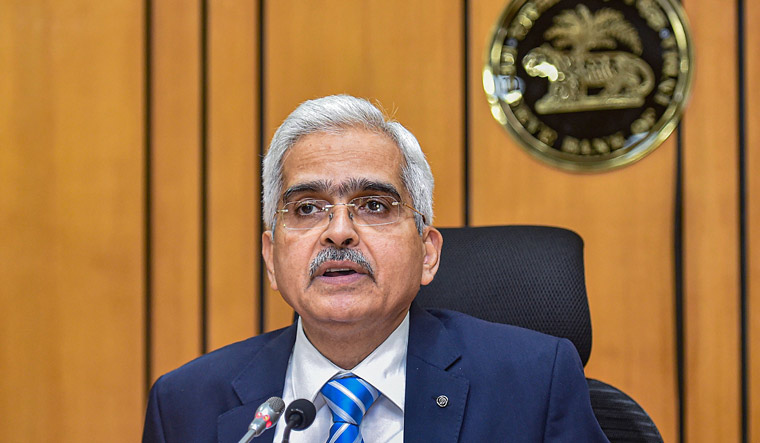The Monetary Policy Committee (MPC) of the Reserve Bank of India on Friday unanimously left the repo rate unchanged at 4 per cent as growth continues to take precedence over inflation, which the central bank feels is transitory. The decision was also taken in view of a possibility of a third wave of COVID-19 that will have to be watched out for as well.
This is the seventh consecutive MPC meet that the benchmark policy rate at which RBI lends money to banks has been kept on hold as COVID-19-related uncertainties continue to weigh on the economic recovery. However, the decision to continue with an accommodative stance, despite the rise in inflation, was not as unanimous as Professor Jayanth Varma expressed reservations on this part of the resolution.
Since March 2020, the RBI has reduced the repo rate by 115 basis points, in the backdrop of the pandemic. This is in addition to the 135 basis points in rate cuts since February 2019.
RBI Governor Shaktikanta Das noted that the economic activity had broadly evolved on the lines of the MPC’s expectations in June and the economy was recovering from the setback of the second wave of the COVID-19 pandemic. However, he also pointed that growth remained uneven and there was a need to remain vigilant against any possibility of a third wave of COVID.
“The Reserve Bank remains in ‘whatever it takes’ mode, with a readiness to deploy all its policy levers - monetary, prudential or regulatory. At this juncture, our overarching priority is that growth impulses are nurtured to ensure a durable recovery along a sustainable growth path with stability,” Das said.
A key pressure point central banks are facing currently is a surge in inflation, driven by a sharp rise in commodity costs, that has necessitated price hikes across the board from automobiles, fast-moving consumer goods, and consumer durables. India’s retail inflation in May was highest in six months at 6.30 per cent. Although it cooled slightly to 6.26 per cent in June, it is still trending higher than RBI’s inflation target of 4 per cent, plus or minus 2 per cent.
However, Das believes the current inflationary pressures are supply-led and underlying demand conditions remain weak, tempering the pass-through to output prices and core inflation.
“The recent inflationary pressures are evoking concerns, but the current assessment is that these pressures are transitory and largely driven by adverse supply-side factors,” said Das.
The RBI feels consumer inflation could remain close to the upper tolerance band till the second quarter of the current financial year. However, these pressures are expected to ebb in the third quarter, as Kharif harvest arrives and supply-side measures take effect.
It has projected inflation at 5.7 per cent for the year ending March 2022. It is expected at 5.9 per cent in the second quarter (up from 5.4 per cent projected earlier), 5.3 per cent in Q3 (versus earlier expectation of 4.7 per cent) and 5.8 per cent in Q4 (compared with 5.3 per cent forecast earlier).
It also retained real GDP growth projections at 9.5 per cent in 2021-22.
“External demand remained buoyant during Q1 2021-22 and was reflected in increasing exports, lending critical support to aggregate demand. Strong external demand is an opportunity for India and further policy support should help in capitalising on this,” said Das.
However, global commodity prices and episodes of financial market volatility, together with vulnerability to new waves of infections are downside risks to economic activity, he added.
also read
- IMF raises India's growth projection to 6.8 pc; growth in China likely to slow to 4.6 pc
- Normal monsoon predicted for 2024. Is it enough to bring down inflation?
- Climate change poses challenges for monetary policy, says RBI report
- RBI governor calls for for greater participation of banks in rupee derivatives in India, abroad
Since the onset of the COVID-19 pandemic back in March 2020, the central bank has ensured there is ample liquidity in the system to boost domestic demand. Buoyed by the renewed vigour of capital inflows and the RBI’s purchase of government securities in the secondary market, total absorption through reverse repo operations has surged from a daily average of Rs 5.7 lakh crore in June to Rs 6.8 lakh crore in July 2021 and further to Rs 8.5 lakh crore in August 2021 so far.
The RBI has proposed to conduct two more auctions of Rs 25,000 crore each through GSAP 2.0, its secondary market government securities acquisition programme.
The central bank is also extending the on-tap targeted long-term repo operations (TLTRO scheme) by three months to December 31, 2021.
The marginal standing facility, through which banks were allowed to avail funds by dipping into the statutory liquidity ratio (SLR) up to an additional one per cent of net demand and time liabilities, is also being extended up to December 31, 2021.
This dispensation provides increased access to funds to the extent of Rs 1.62 lakh crore and qualifies as high-quality liquid assets for banks’ liquidity coverage ratio, according to Das.





